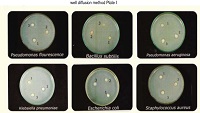Antibacterial activity of herbal preparation –Agnijith
Keywords:
antibacterial activity, herbal preparation, Agnijith, microorganisms, well diffusion method, MIC methodAbstract
“Agnijith” a herbal preparation was evaluated against fifteen different microorganisms at different concentrations 120mg, 130mg, 150mg, 170mg and 190mg/100mg. Chloromphenicol was used as control. The in vitro antibacterial activity was performed by agar well diffusion method and minimum inhibitory concentration (MIC) method. “Agnijith” was found to be more potent in inhibiting the microorganisms such as Bacillus subtilis, Klebsiella pneumoniae, Escherichia coli, Staphylococcus aureus, Pseudomonas aeruginosa, Pseudomonas flourescence, Proteus mirabilis and Shigella dysentriae, whereas no inhibition zone was found against Micrococcus luteus, Streptococcus pyrogens, Enterococcus faecalis, Proteus vulgaris and Salmonella typhimurium by well diffusion method. The zone of inhibition ranges from 12mm to 25mm. Bacillus subtilis, Klebsiella pneumoniae, Staphylococcus aureus, Pseudomonas aeruginosa, Pseudomonas flourescence, Shigella dysentriae were found to be sensitive at various concentrations by minimum inhibitory concentration method. The results clearly demonstrates that the “Agnijith” to be an effective antibacterial agent and could be used to treat diseases caused by microorganisms.
References
Gulzar A, Manju P and Anita Singh. Review and Research. Wound Healing potential of Some Medicinal Plants. J. of Pharmaceutical Sciences 2011;9(1) : article 026.
National Committee for Clinical Laboratory (NCCLS). Standards Methods for dilution, antimicrobial susceptibility test for bacteria that grow aerobically-Second Edition; Approved Standard, NCCLS document M7-A2. Villanova.Pa; NCCLS(1990).
National Committee for Clinical Laboratory Standards (NCCLS). Performance Standard for Antimicrobial susceptibility testing; Ninth Informational supplement. NCCLS (1999). 21.
Nwankwa LV and Amaechi N. Preliminary phytochemical screening and antimicrobial potentials of Anacardium occidentales. J. of research in antimicrobials 2013a; 1(2): 068-074.
Sambath kumar K.P, Debjit B, Duraivel S and Umadevi M . J. of Pharmacognosy and Phytochemistry. 2012; 1(3); ISSN 2278-4136.
Shaahank M, Khosla K.K, Cathrin M and Debjit B. Preliminary phyotochemical studies of Kalanchoe pinnata (Lann) pers. J. of Medicinal Plant Studies 2013;1 (2); 19-23.
Shashank M, Ajay K.J, Majo J, Cathrin M and Debjit B. Analgesic and Anti- Inflammatory Activity of Kalanchoe pinnata (Lann ) Pers. J. of Medicinal Plant Studies 2013; 1(2): 24-28
Vinod B, Devikirani P, Sanjay R, Ahul M. Science Research Report 2013; 3(1): 33-37.
Aboaba O, Efuwape BM, Antibacterial properties of some Nigerian species. Bio Res Comm. 2001;13:183–188.
Joe B, M. Vijaykumar and B.R. Lokesh. Biological properties of curcumin-cellular and molecular mechanisms of action. Food Sci. Nutr 2004; 44: 97-111.



